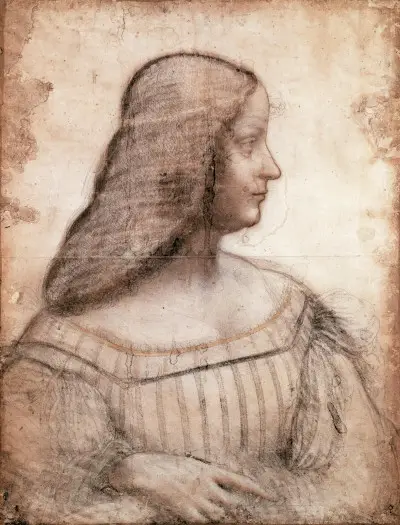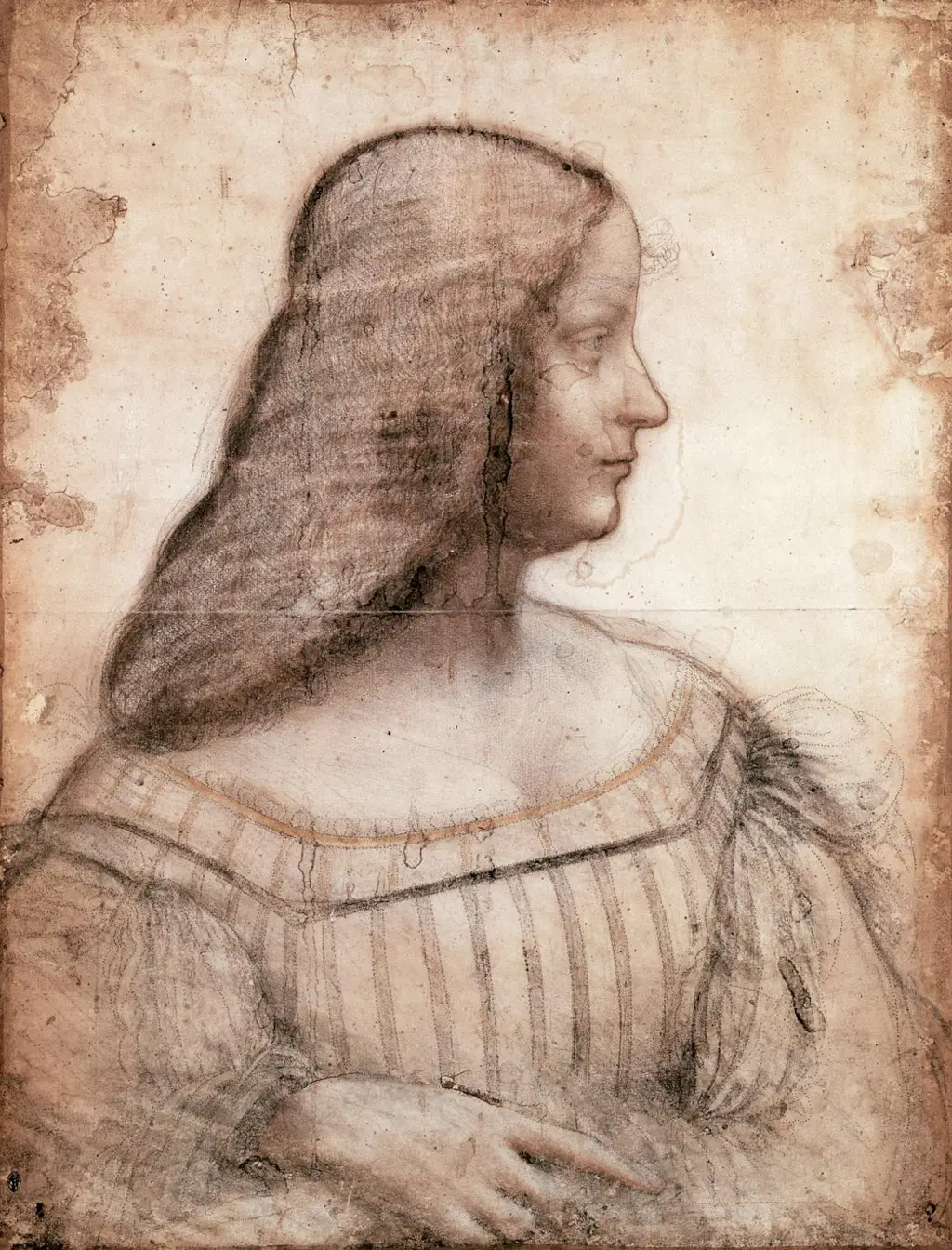Leonardo da Vinci produced this portrait drawing of Isabella d'Este in the late 15th century. She was an important figure within the Renaissance, commissioning a large number of projects for the major artists of that era.
Introduction
Leonardo was regularly courted by Isabella d'Este over a number of years, but he did not always agree to her requests. In some cases he would abandon projects which would then be taken on by others, but he was happy to produce this charming portrait drawing, with perhaps a painting intended to come from it at a later date.
This portrait was created using different tones of chalk, but this medium only appeared later on in the artist's career. He had already mastered this alternative choice by the late 15th century, as demonstrated by this charming portrait which is both subtle but also detailed.
He is believed to have completed this piece whilst relocating from Milan to Florence and he also made another copy of it at the time. Da Vinci would have planned to then use these as a basis for a series of more detailed drawings, and then possibly a painting after that. He showed the drawing to a friend, who later reported to Isabella that:
"...The portrait is exactly like you, and it could not have been done better..."
Leonardo's friend, reporting back to Isabella d'Este
Isabella's clothing is described as being French in style, which goes slightly against the fashions of the time. The fit of her dress was also aimed at hiding her curvaceous nature, something that was reported in correspondence between different European powers. The artist was also willing to tweak her image to make it as complementary as possible, whilst keeping her entirely recognisable.
Some have argued that the side profile of Isabella makes it impossible to convey the same connection that we have with other Da Vinci portraits. She may have insisted on this angle as a means to remind us of her role in Italian society, but it leaves us less curious than we are with other portraits from his career.
In this article we examine the life of Isabella d'Este, with a particular focus to her contribution in the field of Renaissance art. We consider her relationship with Da Vinci, and also dissect this particular drawing. There is technical information on the sketch itself, such as the date, medium and size of the piece, as well as a section on where the artwork can be found today, for those looking to view it in person.
Table of Contents
- Introduction
- Who was Isabella d'Este?
- Description
- Condition
- Date
- Location
- Size and Medium
- Large Image
- References
Who was Isabella d'Este?
Isabella d'Este served as the Marchioness of Mantua but is most famous today as a patron of the arts, and held close friendships with a number of famous Renaissance artists. As a reward for her support, as well her as wider accomplishments, her image can be found in a wide variety of artistic works, from paintings to drawings, plus sculptures and even coins.
Isabella would also play a prominent role in politics, after stepping in to lead Mantua after her husband had been captured. It is generally believed that she was a more competent ruler, which caused a rift with her husband, Francesco, upon his release. Her image within the arts has helped to keep her reputation in our minds, all these centuries later.
Isabella d'Este's Legacy within the Arts
Many consider Isabella d'Este to have been the most important donor within the Italian Renaissance. Much of her life was documented in written correspondence, with letters sent and received still existing in Mantua today. These provide a detailed account of her relationships with a number of famous artists, as well as detail around other parts of her life.
She regularly courted the finest artists for various projects, and some of the biggest names that she commissioned included Giovanni Bellini, Giorgione, Leonardo da Vinci, Andrea Mantegna, Raphael, Titian and Antonio da Correggio, though there were many more besides. Her interest went much further than just painting, though, encompassing most disciplines related to the wider Renaissance, including medal design, literature, music, architecture and sculpture.
Whilst a large number of portraits of Isabella have been identified, there are countless more artworks that have been attributed to her image, tentatively. Many projects lack documentation from this period, and so questionmarks remain over the identity of many portrait models which remain from the Renaissance.
Description
The portrait drawing features Isabella in a side profile, with her shoulders slightly turned towards us. The composition runs from the waist upwards, and the overall image is relatively light in tone, though this maybe due to the age of the piece. The background is left blank, but the artist does deliver strong detail around her facial features, and elements of her clothing too.
The portrait model, generally accepted as being Isabella d'Este, wears a striped dress, with plumed sleeves. Her hands are crossed, with only her right hand visible. It is possible that the piece may have been cropped at some point, because so many of Da Vinci's drawings received the same treatment in the century after he had passed away.
The Marchioness' hair is significant within this piece, as it helps us to identify her. She wore a similar hair style in other portraits, and it was already known that she had a strong relationship with Da Vinci, alongside a number of other famous artists. It is perhaps the way in which he side profile facial features are delivered which makes us think of Da Vinci, with a look which matches many of his other portrait drawings.
The side on profile may well have been chosen by the model herself, and is also consistent with the medal designs of this period, which was an art form in which she was also involved. This angle was also fairly standard within the Italian Renaissance as a whole.
Purpose
It is likely that this drawing was intended to be an early study, with later drawings planned in even greater detail. The purpose of this would be to avoid the model having to sit on several occasions, which would not have been suitable for someone as busy and important as the Marchioness of Mantua.
It may have been intended that after a series of further drawings, that then Da Vinci would have completed a painted portrait, but there is not enough evidence to prove this theory. Due to the reduced detail in this portrait, it is likely that later drawings would have been planned, such are our experiences of how the artist tended to work.
Attribution
It was in around the 19th century that this portrait was identified as likely being of the Marchioness of Mantua, Isabella d'Este. This theory was based on comparisons with coins from that period which featured her image in side profile. In following years, much more evidence would be added, based on newly discovered documentation as well as scientific research into the drawing itself.
Condition
A careful study of the larger image of the drawing below reveals variations in the tone of the paper around the edges. Sadly, there are signs, in the opinions of some experts, that another artist would later touch-up elements of the drawing, using techniques which have not been associated with Da Vinci - quite who this might have been remains something of a mystery.
Date
Leonardo da Vinci's Portrait of Isabella d'Este is dated to around 1499–1500, although art historians continue to dispute its precise date, with other suggestions have also been put forward. The artist would rarely date his drawings, but there are some clues to help date this piece, such as the artist's relationship with the model, Isabella d'Este, as well as his use of chalk for this piece which only appeared later on in his career.
Frank Zöllner provides a more specific date for this piece, of December 1499 to March 1500, which is an unusually specific time period for a Da Vinci drawing. He studied a wide number of 20th century publications on the artist in order to arrive at that estimate, and so this claim holds a good level of confidence.
Location
This drawing can be found in the Louvre gallery in Paris, France. This famous art institution holds a fine selection of drawings from Da Vinci's career, with this portrait of Isabella d'Este being amongst the best known, but it is the paintings which provide the biggest highlights - including the likes of the Mona Lisa, Virgin of the Rocks, Annunciation, Saint John the Baptist and Bacchus.
Provenance
The item was acquired by the Louvre in 1860, and resides in the Prints and Drawings Study Room today, but little is known about its life prior to that point. It is believed to have been in the Calderara collection just prior to the involvement of the Louvre, and was therefore likely owned by Bartolommeo Calderara some years earlier.
Size and Medium
Portrait of Isabella d'Este measures 61 cm in height, by 46.5 cm in width. Leonardo made use of black and red chalk in this detailed piece, with this medium dominating his drawings for several decades, having initially preferred the use of metalpoint and pen and ink instead.
Large Image
See below for a larger, high resolution image of Leonardo's Portrait of Isabella d'Este. This allows you to view some of the facial detail given to the model, as well as elements of her clothing. Da Vinci was a highly skilled draughtsman who delivered subtle variations in tone which might not be viewable in smaller images.
References
- Leonardo. The Complete Paintings and Drawings, Frank Zöllner & Johannes Nathan, Taschen
- Leonardo da Vinci, Walter Isaacson





